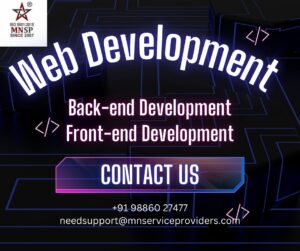
What is Web Development?
In the fast-evolving digital world, web development is the backbone of online success. From small business websites to complex web applications, modern businesses rely on well-structured and high-performing websites to engage users and drive growth.
At MN Service Providers (MNSP), we specialize in building innovative, secure, and SEO-optimized websites that help businesses thrive in the digital age.
Web development involves coding, designing, and optimizing web pages to create functional and interactive user experiences. It can be broadly divided into:
Frontend Development
Frontend development focuses on creating the user interface (UI) and user experience (UX) of a website or application. A frontend developer ensures that the site is:
- Visually Appealing – Engaging and aesthetically pleasing design.
- Responsive – Seamless functionality across all devices.
- Fast & Efficient – Optimized for smooth navigation and performance.

Key Frontend Technologies
HTML (HyperText Markup Language)
The foundation of any webpage, defining its structure and layout.
🔹 Creates headings, paragraphs, images, links, and forms.
🔹 Supports multimedia elements like videos and audio.
🔹 Works with CSS and JavaScript for enhanced functionality.
CSS (Cascading Style Sheets)
CSS enhances website aesthetics and responsiveness.
🔹 Controls colors, fonts, and layouts.
🔹 Enables responsive design through media queries.
🔹 Supports animations and transitions.
Popular CSS Frameworks: Bootstrap, Tailwind CSS, Foundation.
JavaScript (JS)
JavaScript makes websites interactive and dynamic.
🔹 Handles user interactions like clicks and form submissions.
🔹 Supports asynchronous data fetching (AJAX, APIs).
🔹 Powers modern frontend frameworks like React.js, Vue.js, and Angular.
Backend Development
Backend development is responsible for server-side logic, database management, and security. It ensures smooth communication between the frontend and the server.
Key Responsibilities of Backend Development
- Handling user requests and business logic.
- Storing and retrieving data from databases.
- Securing the website with authentication and encryption.
- Integrating APIs and third-party services.
Essential Backend Technologies
Popular Backend Programming Languages
🔹 PHP – Powering platforms like WordPress, Laravel.
🔹 Python – Used with Django and Flask for scalable applications.
🔹 Node.js – Enables JavaScript for backend development.
🔹 Ruby – Works with Ruby on Rails for rapid web development.
🔹 Java – Used in enterprise applications, supported by Spring Boot.
Databases & Database Management Systems (DBMS)
Relational Databases (SQL-based): Store structured data.
MySQL – Open-source and widely used.
PostgreSQL – Advanced database features.
Microsoft SQL Server – Common in enterprise applications.
NoSQL Databases: Handle large volumes of unstructured data.
MongoDB – A document-based NoSQL database.
Firebase – A cloud-based NoSQL solution.
Full-Stack Development
A full-stack developer handles both frontend and backend development, making them highly sought after in the tech industry.
Why Become a Full-Stack Developer?
- High Demand – Companies seek versatile developers.
- End-to-End Development – Master both frontend and backend.
- More Career Opportunities – Higher salary and career growth potential.
Popular Full-Stack Technologies
- MERN Stack – MongoDB, Express.js, React, Node.js.
- LAMP Stack – Linux, Apache, MySQL, PHP.
- MEAN Stack – MongoDB, Express.js, Angular, Node.js.
Web Hosting & Deployment
Once a website is developed, it needs to be deployed on a hosting platform to be accessible to users worldwide.
Types of Web Hosting
Shared Hosting – Affordable, but with limited resources.
VPS (Virtual Private Server) – Offers more control and performance.
Cloud Hosting – Scalable solutions (AWS, Google Cloud, DigitalOcean).
Dedicated Hosting – Full control over a server for high-traffic websites.
Website Deployment Methods
- FTP/SFTP – Manual file uploads to a server.
- Git & GitHub Actions – Automated deployments using version control.
- CI/CD Pipelines – Continuous integration and deployment with Jenkins, GitLab CI.
Must-Have Web Development Tools
Modern developers rely on a variety of tools to improve efficiency and streamline workflows.
- Code Editors: VS Code, Sublime Text, Atom.
- Version Control: Git, GitHub, GitLab.
- Browsers & DevTools: Chrome DevTools, Firefox Developer Edition.
- Package Managers: npm, Yarn.
- Design Tools: Figma, Adobe XD, Canva.
- Testing Tools: Jest, Selenium, Postman (for API testing).
Quick Web Development Tips
- Optimize Website Speed – Compress images, enable caching, and use a CDN.
- Ensure Mobile Responsiveness – Design websites that adapt to all screen sizes.
- Use Clear Navigation – A well-structured menu improves UX.
- Enhance Security – Use SSL certificates, two-factor authentication, and regular updates.
- SEO Best Practices – Implement meta tags, alt text, and keyword-rich content.
Conclusion
Web development is an exciting and ever-evolving field with limitless opportunities. Whether you’re a beginner starting your journey or an experienced developer refining your skills, mastering frontend development, backend development, and full-stack technologies can help you build dynamic and high-performing websites.
At MN Service Providers (MNSP), we specialize in crafting responsive, secure, and SEO-optimized websites to help businesses thrive in the digital landscape.
Ready to build your online presence? Contact MNSP today and let’s create something amazing together!

